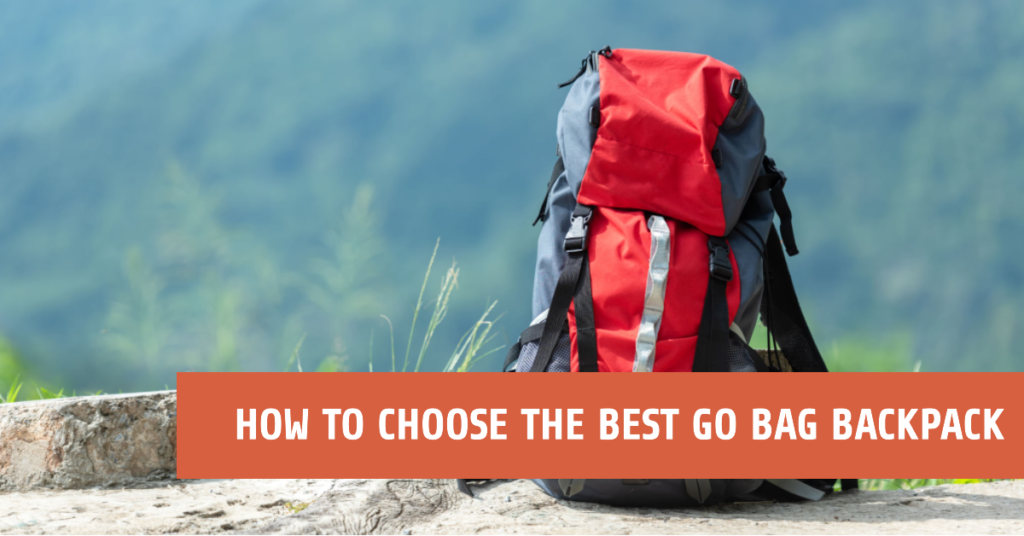
A go bag is your lifeline in emergencies, and the backpack you choose plays a crucial role in its effectiveness. Selecting the right backpack ensures that you have ample space, accessibility, and durability for your go bag essentials. This guide will focus on the critical aspects of choosing the best go bag backpack by examining capacity, comfort, and ergonomics.
Go Bag Capacity
Determining the Right Size Based on Your Needs
Your go bag backpack’s capacity should accommodate your specific needs in emergencies. Consider the duration of potential emergencies, the number of people you’re providing for, and the types of supplies you’ll need. Larger backpacks might be necessary for longer durations, while smaller ones may suffice for shorter periods.
Understanding Liters and Carrying Capacity
Backpack capacity is often measured in liters, which indicates the volume a backpack can hold. Backpacks with 30-40 liters are suitable for short-term emergencies, while 50-70 liters cater to longer-term situations. Balancing capacity with weight is crucial; a too-heavy backpack could impede your mobility during emergencies.
Comfort and Ergonomics
Importance of a Comfortable Backpack
A comfortable backpack is essential for easy transportation during emergencies. Discomfort or pain could hinder your ability to move quickly or efficiently. Look for backpacks designed with ergonomics and user comfort in mind to minimize potential issues.
Adjustable Straps and Harnesses
Choose a go bag backpack with adjustable shoulder straps, sternum straps, and hip belts. These features help distribute weight evenly across your body, reducing strain on your shoulders and back. Adjustable straps also ensure that the backpack fits securely, minimizing movement and discomfort as you navigate through emergency situations.
Padded Back Panel and Hip Belt
Padding on the back panel and hip belt enhances comfort during extended wear. The cushioning helps reduce pressure points and discomfort, particularly when carrying heavy loads. Opt for backpacks with ample padding to ensure your comfort during emergencies.
Ventilation and Breathability
Breathability is essential for maintaining comfort during physical exertion. Choose a backpack with a ventilated back panel to promote airflow and minimize sweating. Mesh materials and raised foam padding can provide the necessary ventilation for a comfortable go bag backpack experience.
Durability and Material
Types of Materials
The backpack’s material determines its durability, weight, and resistance to wear and tear. Common materials include nylon, polyester, and ripstop fabric, each with its unique characteristics. Nylon offers high strength and abrasion resistance, while polyester is lightweight and UV resistant. Ripstop fabrics have a reinforced weave, making them resistant to tearing and ideal for heavy-duty use.
Waterproof or Water-Resistant Options
Selecting a waterproof or water-resistant backpack helps protect your go bag essentials from moisture damage. Waterproof backpacks use materials and construction techniques that prevent water penetration, while water-resistant backpacks can withstand light rain or splashes but may not hold up under sustained exposure to water.
Quality of Stitching and Construction
Examine the backpack’s stitching and construction to ensure its durability. Look for reinforced seams, double stitching, and quality hardware like zippers and buckles. A well-constructed backpack can withstand the rigors of emergency situations, keeping your supplies safe and secure.
Denier Rating and Material Thickness
An important factor to consider when evaluating the durability of a go bag backpack is its denier rating. Denier is a unit of measurement that indicates the thickness of the material used in the backpack. A higher denier rating typically correlates with a stronger, more durable material. When selecting a backpack, look for those with a higher denier rating, as they are likely to be more resistant to wear and tear.
YKK Zippers and Other Hardware
The quality of the zippers and other hardware on a go bag backpack can significantly impact its durability and longevity. YKK zippers are widely considered to be the industry standard for high-quality, reliable zippers. When comparing backpacks, pay attention to the zippers and other hardware used, and opt for models that utilize YKK zippers and other high-quality components.
Organization and Accessibility
Number and Types of Compartments
A go bag backpack should have multiple compartments to organize and store supplies efficiently. Consider backpacks with a mix of large, main compartments for bulkier items and smaller, secondary compartments for organizing smaller supplies. Easy access to your items is crucial in emergencies.
Internal and External Pockets
Internal and external pockets provide additional storage and organization options. Mesh pockets are ideal for holding items you need to access quickly, while zippered pockets can secure smaller, valuable items. When selecting a backpack, consider the types and number of pockets that best suit your needs.
Quick Access Pockets and Panels
In emergency situations, having quick access to your go bag essentials is crucial. Some go bag backpacks feature quick access pockets and panels that allow you to access important items without having to rummage through the entire bag. When selecting a backpack, consider models with quick access features to help you stay organized and prepared.
MOLLE Webbing and Attachment Points
MOLLE (Modular Lightweight Load-carrying Equipment) webbing is a feature found on many tactical and outdoor backpacks. This system allows you to attach additional pouches and accessories to your backpack, expanding its storage capacity and customization options. If you anticipate needing to attach extra gear, consider a backpack with MOLLE webbing and attachment points.
Customization and Personalization
Customizable Patches and Identification
When selecting a go bag backpack, consider models that allow for customization and personalization. Some backpacks feature Velcro patches or other attachment points for adding identification, morale patches, or other personal touches. Customizable patches can help you quickly identify your backpack, especially in group emergency situations.
Color Options and Camouflage Patterns
Go bag backpacks are available in various colors and camouflage patterns. When choosing a backpack, consider your specific needs and preferences. Bright, high-visibility colors can be helpful in search and rescue situations, while camouflage patterns may be better suited for those looking to blend in with their surroundings.
Customizable Strap Systems
A customizable strap system can provide added comfort and functionality when wearing a go bag backpack. Some backpacks feature adjustable and removable straps, allowing you to configure the bag to fit your body and carry preferences. Look for backpacks with customizable strap systems to ensure a comfortable fit and efficient weight distribution.
Additional Go Bag Features
Integrated Rain Cover
An integrated rain cover is a valuable addition to your go bag backpack. This feature provides extra protection for your go bag essentials during heavy rain or wet conditions. When not in use, the rain cover can be easily stowed away in a designated pocket.
Hydration Bladder Compatibility
Hydration bladder compatibility is crucial for maintaining hydration during emergency situations. Backpacks with a dedicated compartment or sleeve for a hydration bladder make it easy to access water without stopping to search for a water bottle. Additionally, hydration tubes allow for hands-free drinking while on the move.
Compression Straps
Compression straps help stabilize and secure your load, making the backpack more comfortable to wear. These straps can also be used to attach additional gear or to reduce the backpack’s overall size when not fully loaded.
Price and Budget Considerations
Finding a Balance Between Quality and Cost
When choosing a go bag backpack, it’s essential to find a balance between quality and cost. While it may be tempting to select the cheapest option, investing in a durable and reliable backpack can save money in the long run by preventing the need for frequent replacements. Research different options within your budget to find a backpack that meets your needs without breaking the bank.
Comparing Various Brands and Models
Take the time to compare various brands and models to find the best go bag backpack for your needs. Read reviews, ask for recommendations, and consult trusted sources for information on backpack quality and performance. Comparing options can help you identify the features and price range that best align with your preferences.
Reviews and Recommendations
Researching Online Reviews and Testimonials
To find the perfect go bag backpack, spend time researching online reviews and testimonials. Websites, forums, and social media platforms can provide valuable insights into the performance and durability of various backpack models. Reading real-life experiences can help you make an informed decision when selecting a backpack for your go bag essentials.
Asking for Recommendations from Friends and Family
Don’t hesitate to ask friends and family for their recommendations when searching for a go bag backpack. They may have first-hand experience with specific brands or models and can provide valuable insights into their functionality and durability.
Preparing Your Go Bag Backpack
Packing the Essentials
Once you’ve selected the perfect go bag backpack, it’s time to pack your go bag essentials. Ensure you have a well-stocked first aid kit, adequate food and water supplies, essential tools, and important personal documents. Be sure to keep these items organized and easily accessible within your backpack.
Regularly Reviewing and Updating Your Go Bag
It’s essential to regularly review and update the contents of your go bag backpack to ensure you are always prepared for an emergency situation. Check the expiration dates on food and medical supplies, replace any used or damaged items, and update personal documents as needed. Regularly reviewing and updating your go bag will help you stay ready for any emergency.
Practicing with Your Go Bag
Familiarizing yourself with the contents and layout of your go bag backpack is essential to being prepared in an emergency. Take the time to practice accessing and using your go bag essentials, and consider participating in emergency drills or training exercises. The more comfortable you are with your go bag, the better equipped you’ll be to handle a real-life emergency situation.
Storing Your Go Bag Backpack
Proper storage of your go bag backpack is crucial to ensure its contents remain in good condition and readily available when needed. Store your backpack in a cool, dry location, away from direct sunlight or extreme temperatures. Be sure to keep your go bag in a place that is easily accessible, so you can grab it quickly in the event of an emergency.
Conclusion
Recap of Important Features and Considerations
In summary, key features and considerations when choosing a go bag backpack include capacity, comfort, durability, organization, additional features, price, and budget. By carefully evaluating these factors, you can select a backpack that meets your needs and ensures you are prepared for emergencies.
Importance of Investing in a High-Quality Go Bag Backpack
Investing in a high-quality backpack is essential for keeping your go bag essentials secure and accessible in emergency situations. A well-designed backpack can make all the difference when it comes to ensuring your safety and well-being during an emergency. Don’t compromise on quality; choose a backpack that will stand the test of time and provide the functionality you need.
